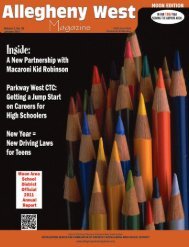June 2013 - Allegheny West Magazine
June 2013 - Allegheny West Magazine
June 2013 - Allegheny West Magazine
Create successful ePaper yourself
Turn your PDF publications into a flip-book with our unique Google optimized e-Paper software.
Superintendent’s Message:<br />
Understanding the Common Core Standards<br />
Introduction by<br />
Dr. John DiSanti, Superintendent<br />
Over the last several weeks, much has been<br />
written about the Common Core. What is it<br />
What does it mean for Pennsylvania schools<br />
How will it affect teachers and students in our<br />
state and in particular <strong>West</strong> <strong>Allegheny</strong> Dr.<br />
Christine Assetta, Assistant to the Superintendent<br />
for Curriculum and Instruction, is<br />
charged with overseeing the implementation of<br />
the Standards in <strong>West</strong> <strong>Allegheny</strong>. Given her<br />
experience and expertise in curriculum, I<br />
asked her to provide an overview on the<br />
Common Core and its implications for <strong>West</strong><br />
<strong>Allegheny</strong>. I hope that her synopsis offers a<br />
more in-depth understanding of what the<br />
Common Core is and how districts across the<br />
country are implementing this initiative.<br />
Over the past year, the <strong>West</strong> <strong>Allegheny</strong><br />
School District has begun the process of<br />
revising the present District curricula to be<br />
aligned to the revised Pennsylvania Common<br />
Core Standards. The Pennsylvania Department<br />
of Education is mandating that all<br />
Pennsylvania school districts develop<br />
curricula with instructional objectives and<br />
learning activities aligned to Common Core<br />
expectations by the 2014-2015 academic year.<br />
The <strong>West</strong> <strong>Allegheny</strong> School District will meet<br />
this expectation by adhering to the timeline in<br />
the chart on the right.<br />
With the introduction of the Pennsylvania<br />
Common Core Standards, parents and<br />
community members have raised questions<br />
regarding their use, origin, and implications for<br />
the <strong>West</strong> <strong>Allegheny</strong> School District. The<br />
purpose of this article is to address those<br />
questions in order to clarify their use and<br />
correct any misperceptions.<br />
What are the Common Core Standards<br />
and What are their Origins<br />
Common Core Standards are statements of<br />
what students are expected to know and be<br />
able to do at specific grade levels. Standards<br />
focus on essential concepts, knowledge, and<br />
skills necessary for students to succeed and<br />
are designed to increase student achievement.<br />
In 2004, various states worked in collaboration<br />
to determine if common standards in<br />
math and English could be identified for states<br />
to consider using. The need for these<br />
statements evolved from the business<br />
community and higher education officials<br />
stating the need for more rigorous academic<br />
standards to produce high school graduates<br />
ready to succeed in the workforce or college.<br />
Their perspective is based on the belief that the<br />
way students were taught in the past does not<br />
prepare them for the higher demands of careers<br />
and college in the twenty-first century.<br />
What are the<br />
Pennsylvania Common Core Standards<br />
Each state has the autonomy to design<br />
Common Core Standards to meet the specific<br />
needs of their students. The Common Core<br />
Standards provide clear and consistent<br />
standards for all states to consider when<br />
developing their state-specific standards for<br />
math and English. As a result, the Pennsylvania<br />
Department of Education has designed the<br />
Pennsylvania Common Core Standards that<br />
include evidence-based, rigorous content and are<br />
aligned to college and career readiness. The<br />
Pennsylvania Common Core promotes a deeper<br />
level of understanding of key concepts in the<br />
areas of math and literacy.<br />
In English language arts and literacy, Pennsylvania<br />
students continue to read and write.<br />
However, in addition to narrative stories and<br />
literature, they read more informational text that<br />
provides facts in areas including science and<br />
social studies. Students build background<br />
knowledge about the world through the text and<br />
learn to rely less on the teacher or activities.<br />
They also read more challenging texts and are<br />
asked more questions that require them to refer<br />
back to what they have read. There is a greater<br />
emphasis on building strong vocabulary as a<br />
tool to enhance comprehension. Additionally,<br />
writing is emphasized. Students continue to<br />
write narrative passages, but they also use<br />
evidence from text to inform and make an<br />
argument based on what they are reading.<br />
In math, the instruction emphasis is on<br />
interrelated big ideas that connect the study of<br />
mathematics to science, technology, and<br />
engineering. Teachers concentrate on the big<br />
ideas of concepts using complex and challenging<br />
math content. This enables the students to<br />
demonstrate their thinking and apply their<br />
knowledge in different ways. Students learn how<br />
to use math to analyze and respond to realworld<br />
issues and challenges as they will be<br />
expected to do in college and the workplace.<br />
Common Core Myths and Facts<br />
As a result of the implementation of the<br />
Pennsylvania Common Core Standards, several<br />
of the following misconceptions have surfaced.<br />
Following each myth is a clarification of the<br />
implications of the Pennsylvania Common Core<br />
Standards.<br />
Myth - The Common Core Standards are based<br />
on a national curricula for schools.<br />
Fact - The standards are not a curriculum. They<br />
are a set of goals and expectations for the<br />
necessary knowledge and skills that help<br />
students succeed. Local districts determine how<br />
the standards will be met through specific<br />
instructional objectives, activities, and resources.<br />
Myth - The Common Core Standards include a<br />
required reading list.<br />
Fact - A mandated reading list does not exist.<br />
The Standards recommend a wide range of<br />
narrative and informational texts with the<br />
district holding the autonomy to select specific<br />
reading material.<br />
Myth - The Common Core Standards will lead to<br />
Pennsylvania taking a national test.<br />
Fact - No national test exists. Pennsylvania<br />
students are only required to take the PSSA<br />
exams in grades 3-8 and the Keystone Exams<br />
upon completion of algebra I, biology, and<br />
English.<br />
Myth - The Common Core Standards lessen the<br />
rigor of Pennsylvania State Standards.<br />
Fact - The Common Core Standards improve the<br />
rigor in schools. The curricula aligned to the<br />
standards address a much higher level as<br />
students are expected to perform beyond the<br />
basic knowledge level and engage in strategic and<br />
extended thinking.<br />
Implications for the<br />
<strong>West</strong> <strong>Allegheny</strong> School District<br />
As the <strong>West</strong> <strong>Allegheny</strong> School District<br />
transitions to the Pennsylvania Common Core<br />
Standards, parents will notice more rigorous<br />
expectations for students with an emphasis on<br />
conceptual understanding as opposed to the<br />
simple recall of facts. <strong>West</strong> <strong>Allegheny</strong> is<br />
committed to designing curricula that addresses

















